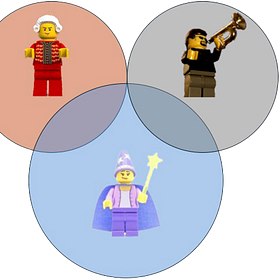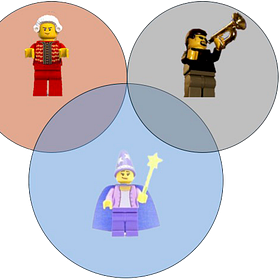
This series is an adaptation of my 2024 AVCA presentation of the same name. I have posted the video and slides previously. You can find links to the presentation video, slides, and resources at the bottom of this post.
This is part 2 of the series. It describes two broad categories of coaches based on how they set problems. You can find part 1 (and a reminder of what problem setting is) here:
In part 1, I quoted philosopher Donald Schön and sociologist Howard Becker to define problem setting and suppressed premises. I’ll return to Becker’s work again to set up two main ways that coaches can see the worlds in which they coach. Becker called these two ways the “Society as Machine trick” and the “Society as Organism trick”. Instead of describing the tricks themselves, I’ll describe coaches that use those tricks to see their coaching world.
The Classical Coach
I’ll start with a musical introduction. Here’s a snippet of the overture from Mozart’s Marriage of Figaro played by a full orchestra:
For comparison, here’s a clip of the same passage, but played by string quartet:
And, just for fun, here’s a clip of the same passage, but from Baby Einstein:
It becomes clear that classical music is fairly standardized and structured. The musicians have some room for expression, but they are ultimately responsible for playing the notes on the page in a recognizable way.
Classical coaches are those that coach from that perspective, that there’s a specific way things work and that way is knowable and repeatable. Becker called this “the machine trick” and he described it this way:
“It requires us to think like engineers who want the machine they design to do what it is supposed to do…” (Becker 2008, p. 39)
Coaches who use the machine trick tend to think their worlds act…
“...in a very repetitive way, delivering essentially similar products by following a systematic procedure…” (Becker 2008, pp. 40-41)
Classical coaches tend to believe there are fairly well-known goals and standards (the notes on the page, the way the music has always been played). They believe there are fairly well-known methods of moving towards those goals and standards. They’ve done a lot of work to figure out what should be done and how to make it repeatable.
Classical coaches tend to consider knowledge to be modular and external, meaning that knowledge exists as a set of things that you can hear, read and watch. This knowledge can be transmitted to others and acquired from others. Classical coaches acquire knowledge and store it away for later use. They want to learn by searching for, then watching or reading the “right” pieces of knowledge. They are always looking for pieces of knowledge they either don’t yet have or is better than what they currently have. Classical coaches tend to teach by showing and telling what to, how to do it, and when to do it.
The Jazz Coach
Another musical introduction. This time, a jazz standard, “But Not for Me”, sung by Frank Sinatra:
And now, the same song played by Miles Davis:
Last, the same song, again by Miles Davis, but the very next take during the same recording session:
What you hear in these three clips is that structure and melody still exist, but there’s much more room for variation. You can recognize the melody, even as the musicians make changes to it. You can hear common harmonies and themes, even as you notice different approaches to the “same” song.
Jazz coaches adopt an approach of variation within a larger structure. They acknowledge the complex nature of music, but see some structure and predictability they can leverage. This approach is what Becker called “the organism trick” and he described it as seeing the world as…
“...a series of interconnected processes. When we think this way, we emphasize the connectedness rather than, as with the machine image, the repetition. Things won't always be the same, but from day to day they will be connected to one another in much the same way…” (Becker 2008, p. 41)
He continues…
“Something will vary and something else, dependent on what happens to the first thing, will undergo some change as well. The things that so vary will often influence each other in complicated ways…” (Becker 2008, p. 41)
Jazz coaches tend to focus more on interactions and connections than on specific techniques. As a result, there is less rigidity about what their “music” sounds like within reason. Goals still matter to jazz coaches but there isn't necessarily one best way to achieve them. They know the results they want to produce but how they get to those results varies. They allow, or even encourage, variation that still moves them towards desired outcomes.
Jazz coaches tend to believe knowledge can still be modular but what they know exists in an interconnected web and “knowing” something means seeing how it fits into that web. To a jazz coach, learning is a process of not just finding more things but also seeing more connections between those things in a growing web. A jazz coach teaches by pointing out connections to those who have yet to see them.
Problem Setting
How does a good coach set problems? What they see as problems is determined by their view of the world, so classical and jazz coaches have different ways of setting problems. Different coaches, without realizing it, will ask different questions of themselves and of the situations they encounter to set problems. Here’s a table that sums up their approaches.
This table is far from exhaustive in terms of the questions coaches may ask as they problem set, but it is a good introduction to get you thinking about the questions you ask in your own coaching. It is likely that you don’t fit into one world of coaching all the time, and that’s okay, it’s good to learn when you tend to be one kind of coach and when you tend to be a different kind of coach. Some of the things you do might not fit neatly into one world or the other, and that’s good to recognize as well. While it’s valuable to learn about different general approaches to problem setting, the most important messages I can communicate here are that who you are matters and that reflecting on who you are helps.
In part 3, I’ll give more detail about how classical and jazz thinking influence your perspective on situations and I’ll give you a way of moving from good coaching to great coaching. (There will also be more music.)












Love it! I am still slow walking the difference between training in a random, distributed, even chaotic environment because we learn better that way vs matching the Performance mode because it transfers better. It is tempting to take an inch deep insight and spread it too widely!